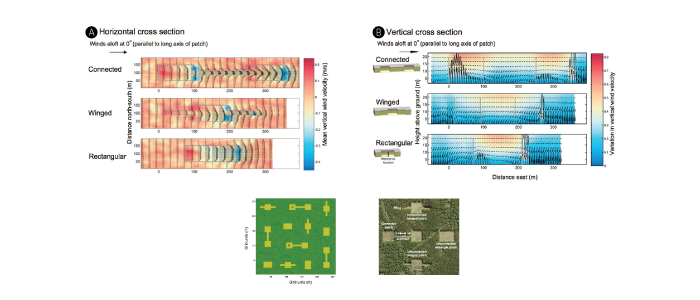Top (A & B): In a study of how forest corridors could impact seed dispersal, Bohrer created a computer model to determine cross-sections of wind dynamics and seed ejection probabilities. The arrows correspond to horizontal wind speeds and directions.
Bottom: Bohrer created a simulation domain (left) with a five-meter resolution, and an aerial photograph (right: Damschen/UW-M) reveals the experimental landscape used in the study.
A team of field ecologists has concluded that woodland corridors connecting patches of endangered plants not only increase dispersal of seeds from one patch to another, but also create wind conditions that can spread the seeds for much longer distances. The idea for the study emerged from modern animal conservation practices, where landscape connectivity – the degree to which landscapes facilitate movement – is being used to counteract the impacts of habitat loss and fragmentation on animal movement.
Gil Bohrer, Ph.D., an assistant professor in the Civil, Environmental & Geodetic Engineering department at The Ohio State University, and colleagues led by Ellen Damschen, Ph.D., an assistant professor of Zoology at the University of Wisconsin, wondered if similar interventions might aid plants that rely upon wind currents.
The field experiment involved connecting open patches of land by cutting gaps and corridors out of a longleaf pine plantation in South Carolina. A network of sensors was erected to provide observations on wind speed, turbulence, temperature and humidity. Seed traps sampled seed arrival at many points in and around the gaps, and hundreds of artificial seeds made of black-light fluorescent yarn were released and recovered in several controlled experiments.
These very large experimental efforts provided a novel dataset of observations of seed movement and wind in patch-corridors landscapes, which scientists leveraged to generate a virtual and complete environment. Bohrer ran the dataset through a high-resolution atmospheric model that he had developed on Ohio Supercomputer Center systems.
“The massive simulations used the Ohio Supercomputer Center to provide a detailed understanding of how corridors change the movement of the wind, and seeds that disperse with it, through a forest,” Bohrer said.
The model resolves the wind flow and includes the effects of canopy leaves and tree stems on the wind. The simulations include a virtual domain of roughly 6.5 million pixels, each representing a volume of air (or air mixed with forest leaves) of about 10 cubic meters. It also represented millions of dispersing virtual seeds. The model calculated the movement of the air and virtual seeds 20 times per second, over four hours.
“We found that corridors could affect the wind direction and align the wind flow with the corridor, that they accelerate the wind and provide preferable conditions for ejection above the canopy, where long distance dispersal could occur,” said Bohrer.
Project Lead: Gil Bohrer, Ph.D., The Ohio State University
Research Title: How fragmentation and corridors affect wind dynamics and seed dispersal in open habitats
Funding Source: National Science Foundation, Department of Agriculture, Washington University
Website: http://www2.ceegs.ohio-state.edu/~bohrer.17/

